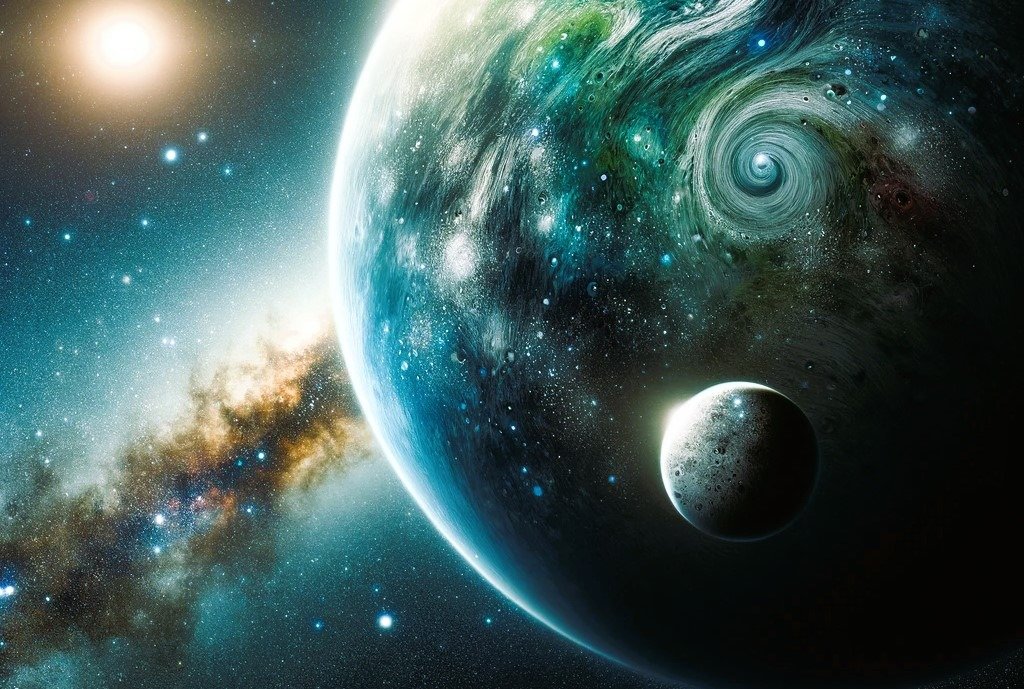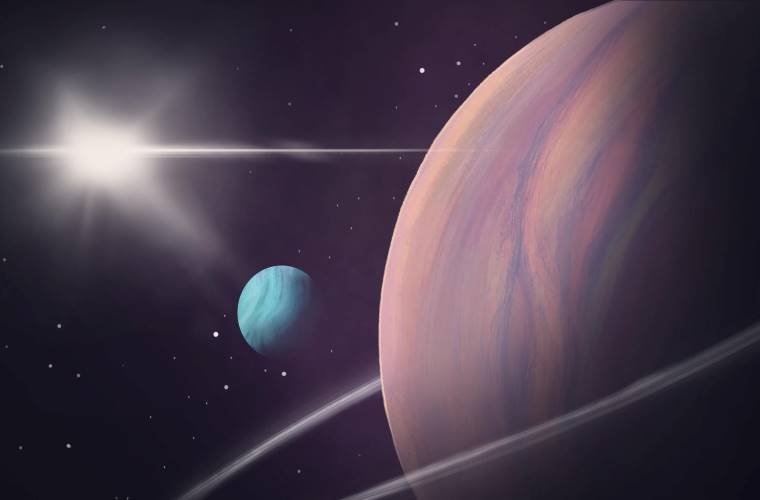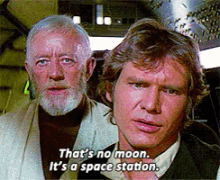
Posted on 01/25/2024 8:36:19 PM PST by Red Badger

The search for exomoons orbiting planets outside our solar system has sparked a significant debate within the astronomical community, involving a pair of contrasting studies that presented divergent viewpoints on the existence of exomoons Kepler-1625b-i and Kepler-1708b-i.
Much like Schrödinger’s oddball cat that is both dead and alive inside a box, we won’t really know until someone goes and looks. But in a new paper recently uploaded to the arXiv preprint server, a team of astronomers led by David Kipping from Columbia University takes issue with the drama surrounding the ongoing exomoon search.
A DISCOVERY GETS DASHED
In 2017, Kipping, alongside Columbia University astronomer Alex Teachey, discovered the first possible exomoon candidate, Kepler-1625b-i, using the Hubble and Kepler telescopes. Years later, in 2022, Kipping, as well as astronomers from NASA, MIT, CalTech, UCLA, and other prominent institutions discovered a second possible exomoon, lovingly called Kepler-1708b-i.
For the astronomers, this was a home run. Not only were astronomers finding exoplanets out there, but finding exoplanets with exomoons. The team focused on known cold gas giants that were far away from their host stars, where the effect of the star’s gravity should not be enough to strip these gas giants of their exomoons. This makes sense. In our solar system, gas giants like Jupiter and Saturn have a lot of moons. It stands to reason that gas giant exoplanets could too.
In December of 2023, a study was published that dashed the exomoon theory against the proverbial lunar rocks. Published in Nature Astronomy, astronomers René Heller and Michael Hippke applied a new algorithm, called Pandora, to the previous exomoon research, and concluded, much like Obi-Wan Kenobi in Star Wars, that those were no moons.
It’s an astronomical roller coaster, and Kipping’s latest paper comes out swinging at Heller and Hippke.
“The reason they didn’t see them [the exomoons] is not because of the data (as they thought),” Kipping told The Debrief. “But it is actually because their algorithm for finding moons didn’t work properly.”
HAVE WE DISCOVERED EXOMOONS OR NOT?
The entire debate circles around light curves. A light curve is a graph that shows the brightness of an astronomical object over time. When it comes to exoplanet and exomoon detection, it typically displays the brightness of a star as a function of time.
The primary method used to detect exoplanets, and by extension exomoons, is the transit method. This method observes the brightness of a star and looks for periodic dimming, which indicates that a planet (or potentially a moon) is passing in front of the star, blocking some of its light. When an exoplanet transits its star, it causes a distinct dip in the star’s brightness. This dip is periodic (it happens at regular intervals) and consistent in depth (the amount of dimming), which corresponds to the size of the planet and its orbit.
Detecting exomoons is more challenging because they are smaller and cause much subtler dips in brightness. Additionally, the moon’s orbit around the planet adds another layer of complexity, as it can cause irregularities in the timing and duration of the transit signal.
As telescopes monitor these “exo-objects,” the light curve graph essentially shows these regular shifts in light across a period of time. If they follow a pattern, like the orbit of a planet, or in this case, a moon, you have a new candidate.
According to Heller and Hippke, as well as the Pandora algorithm, the light curves that gave Kipping and his team the indication of exomoons didn’t fit their models. Pandora simulated various planet-moon combinations and their potential light curves. Using that data, the algorithm compared these simulated light curves with the actual observed data from Kepler and Hubble. Heller and Hippke concluded that the observed light curves were more consistent with a planet-only model, rather than a planet-moon model.“We would have liked to confirm the discovery of exomoons around Kepler-1625b and Kepler-1708b,” said Heller in 2023. “But unfortunately, our analyses show otherwise.”
With the gauntlet now resting firmly on the alleged exomoon surface, the Columbia University team responded in the way academics always do. They wrote a paper.
Kipping and his team’s latest “Reply” provides a detailed reanalysis of the Hubble Space Telescope light curve data. The researchers looked for additional, smaller dips in the brightness of the star, occurring due to a moon transiting after or before the planet. Using statistical methods to analyze the light curves, looking for these subtle signals amidst the noise and confirming them against the expected patterns for a moon transit. Indeed, based on their further analysis, something is orbiting those exoplanets.
“Our paper demonstrates exactly how they ended up with the result they got, and why,” Kipping told The Debrief. “Basically the software they used to search for moons missed the moons. We can prove that because using their own exact data we get much better fits. So the moon candidates are still there, in their own data.”
Kipping and the team started by reexamining the light curves obtained from the Hubble Space Telescope. They focused specifically on periods when the exoplanets were transiting the star, causing a measurable dip in brightness. The researchers looked for small, additional dips in the star’s brightness, occurring just before or after the primary transit event caused by the exoplanet. These dips were hypothesized to be caused by moons orbiting the exoplanets, transiting the star in close succession to the planet.
To ascertain the significance of these additional dips and rule out false positives or noise, the team employed rigorous statistical analyses. They specifically used Bayes factors, a statistical tool that quantifies how well the data supports one model over another. In this case, they compared the likelihood of the light curve data fitting a model with moons versus a model without moons. They then performed consistency checks for depth changes in the light curves and analyzed the limb-darkening effect, a phenomenon where the center of a star appears brighter than its edge. This analysis helped them to distinguish between the effects caused by a transiting exoplanet and those potentially caused by a moon.

Image Credit: Helena Valenzuela Widerström
All this was to counter Pandora’s findings that the exomoons were merely false positives. By reanalyzing the data with their methodologies, Kipping and the team aimed to demonstrate that Pandora’s interpretations of the light curves might have overlooked or misinterpreted the subtle signals indicative of exomoons.
We’re both using the same raw telescope observations, just processing them slightly differently,” Kipping said. “But again, that’s not really the point since the moon signals are there either way.”
Kipping explained that he personally isn’t sure if these are real exomoons, but the data itself indicates something is causing those curious dips on the light curve models. Moons or not, according to Kipping, Pandora messed up.
“Our claim is not that these exomoons are definitely there, but rather that the data indicate their existence and we need more observations to confirm or deny them. Heller & Hippke’s algorithm is unable to spot these moon signals, but we show that this is, in fact, a problem with their algorithm, since we again recover the moons using their own version of the data and prove it’s a much better fit,” Kipping said.
“Using their own version of the data, we still recover the exomoon signals. Yet more, we can prove including the moons (again using their own data), leads to a better fit. The moon signals are there, in either version of the data.”
NASA VIDEO AT LINK.........
TO MOON, OR NOT TO MOON. THAT IS THE QUESTION…
It’s complicated. Light curve data is complex and it can be affected by various forms of noise and stellar variability, making it difficult to discern small dips caused by moons. The irregular timing and varying duration of moon transits, due to their orbits around their planets, add complexity to the light curve analysis. Differentiating between a moon’s transit and other potential causes of dimming (like star spots or additional planets) requires careful data interpretation and sophisticated analysis.
However, there is no way to simply look at these distant exoplanets and “see” the moons, so utilizing light curve data and interpreting it is the best we can do.
The pivotal difference lies in both team’s methodological approaches and data interpretation. A comprehensive analysis presented by Kipping and his team focused on identifying subtle dips in starlight, occurring just before or after the primary transit of an exoplanet, potentially indicative of a moon’s transit. Employing sophisticated statistical techniques, particularly Bayes factors, they bolstered their hypothesis of the exomoons’ existence. This traditional approach of reanalyzing existing data with established statistical methods represents a meticulous application of classical astronomical analysis.
Contrastingly, Heller and Hippke’s study introduced Pandora, a novel computational tool designed to simulate a wide array of planet-moon scenarios. By comparing these simulations with actual observed light curves, the study concluded that the observed data more closely resembled planetary models without moons. It’s a methodological shift from a conventional data-driven analysis to a more holistic approach integrating computational simulations.
The final determination of whether these exomoons exist would ideally come from further research and analysis, possibly involving additional observational data or refined analytical techniques. For now, perhaps we could propose that the exomoons exist and do not exist simultaneously, similar to the cat in Schrödinger’s famous experiment.
Quantum mental gymnastics aside, Kipping sees a bright future for the study of exomoons.
“We are on a quest to try and discover other habitable worlds, many of which could be moons, not planets. Moons also influence the planets they orbit, and can even trick us into thinking we’ve seen life when none is present,” Kipping concluded. “So they’re a crucial puzzle piece in our quest for living worlds.
“Right now we’re in the very early days of exomoon hunting, so it’s important we figure out the right way to look for them.”
MJ Banias is a journalist who covers security and technology. He is the host of The Debrief Weekly Report. You can email MJ at mj@thedebrief.org or follow him on Twitter @mjbanias.
XO MOON Ping!...................
Not something, but rather someone!
It’s NCC-1701
Just completed a couple of hours recalculating that dumbass algorithm using the same log-log-deci-trig slide rule that got me my PhD in 1967...
With an 8-sigma uncertainty, there’s no “there” there...
Much less a couple of exomoons...
However, there’s a high probability that there are several Exxon gas stations thereabouts...
· join · view topics · view or post blog · bookmark ·
· post new topic · subscribe ·Google news searches: exoplanet · exosolar · extrasolar ·
Does the Moon cause Earth’s magnetic field?
Is the Moon maintaining Earth’s magnetism?
...Tidal effects caused by the Moon deform Earth’s mantle, and it is this effect that could be simulating the motion of liquid iron alloy making up the planet’s outer core. This would generate and maintain Earth’s magnetic field. It is that magnetic field that protects life’s DNA from the bombardment of cosmic radiation.
Why would we think other star systems would not have moons? They’re quite common to the planets in our solar system. The physics works the same way in other star systems.

My thought exactly. There are other fish to fry.
Actually 25% of the planets (Mercury and Venus) in our solar system don't have moons. If one considers only the rocky planets (which are the ones that might sustain life as we know it), then only 50% of such rocky planets have one or more moons.
Furthermore, only a relatively large moon is likely to make an effective contribution (in addition to the sun's contribution) to ocean tides. Also a large moon can help stabilize a planet's rotational wobble. Unlike the Earth's moon, Mars' moons are likely captured asteroids.
Since the GJ 9827d planet is only 0.0559 AU from its star (Mercury is 0.4 AU from the sun; Earth is 1 AU from the sun), its "year" is only 6.2 earth-days long. No wonder it has a temperature claimed to be 800 deg F.
It is far-fetched to use any claimed characteristics of such a planet in such close orbit around a K-type orange-dwarf star to hype for the existence of an Earth-sized, liquid-water-containing planet with a comparable moon at suitable distance from a G-type star (like our sun). But it can be used in more research grant applications.
Disclaimer: Opinions posted on Free Republic are those of the individual posters and do not necessarily represent the opinion of Free Republic or its management. All materials posted herein are protected by copyright law and the exemption for fair use of copyrighted works.